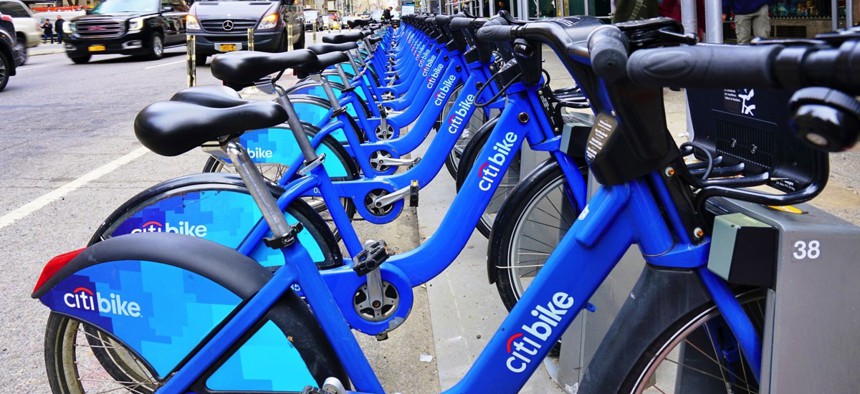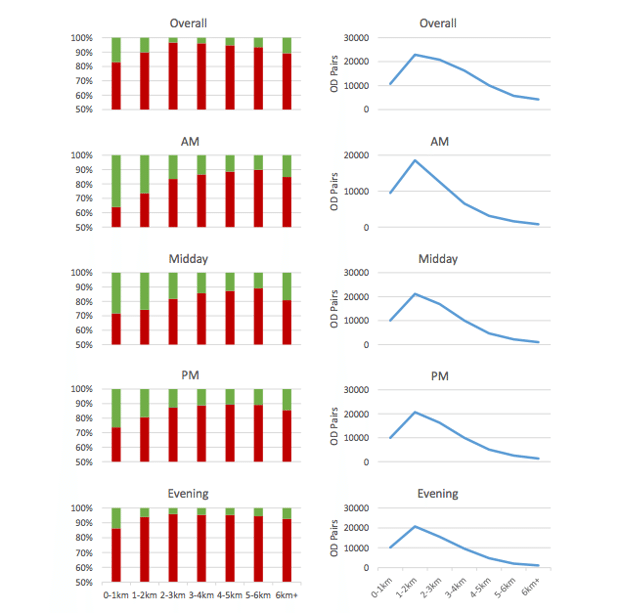In New York City, Bike Share Is Faster Than Cabs When It Matters

As the city strives to cut carbon emissions, backseat travelers should know when there’s a quicker, cleaner route.
Experienced cyclists know that short jaunts are often more quickly accomplished by pedal power than horsepower—especially in ultra dense, ultra congested New York City. But as the Big Apple strives to cut carbon emissions through reining in car traffic and ramping up expansion of its bike-share program, city leaders might do well to remind short-distance backseat travelers of that fact.
It’s already established that a huge share of taxi and bike-share trips cover comparable distances in New York City. In 2014, nearly 34,000 trips were taken using the Citi Bike system per day, while more than 400,000 trips were made by taxi. About 55 percent of the taxi rides spanned less than two miles; so did the average bike-share trip.
Now new research shows that for many of those cab trips, bike share would save time. In a study published in Transportation Research this month, researchers from the University of Toronto and University of Central Florida examined Citi Bike trip data (freely available through the service’s website) and taxi trip data from 2014, and found that bike share can either compete with or beat taxi speeds at the hours it matters most.
The co-authors, Ahmadreza Faghih-Imani, Sabreena Anowar, Eric J. Miller, and Naveen Eluru, examined taxi trips made within the service area of Citi Bike’s stations in 2014. They identified all the taxi trips that traveled from and to locations within 250 meters of a Citi Bike station—a short enough distance that the cab ride could conceivably be replaced by a bike ride—and computed the mean travel times for all of those origin/destination pairs.
They held these numbers up against four different time brackets: morning (7:00–10:00 a.m.), midday (10:00 a.m.–16:00 p.m.), late afternoon (4:00–7:00 p.m.), and evening (7:00–10:00 p.m.), as shown in the chart below.

On average, the researchers found that taxis hailed within range of a Citi Bike station were a slightly faster option than grabbing the rental bike. But when travel distances were shorter, and at times when roads were more likely to be congested, the difference in travel times dropped. On weekdays, more than half of trips shorter than 3 kilometers (about 1.8 miles) went as fast or faster on Citi Bike than in a cab. Citi Bike’s advantage is stronger as trips cover less distance: between 20 and 36 percent of weekday trips shorter than 2 kilometers (about 1.2 miles) went faster on rented spokes than in a backseat.
Note that the rise of Uber and Lyft has changed average car trip distances in New York City to some extent, as those services have absorbed longer-haul transit riders in addition to cannibalizing shorter-haul taxi customers. This study didn’t include ride-hailing trip data from those companies, since that wasn’t available until quite recently. But the research offers a useful framework for a future study that looks at all of these modes next to one another.
It’s not surprising that New York City’s rush-hour congestion is so awful that a clunky, three-speed shared bike beats a fuel-combusting car engine. What’s intriguing here is the car-ride to bike-ride conversion potential. What if Citi Bike tested out rush-hour pricing incentives to lure more commuters onto bikes in key locations? What if the stations offered a simple bike-trip planning tool, so that navigation-averse commuters accustomed to cars feel a little more grounded? What if Citi Bike advertised the simple fact that cycling can be faster than cabs or Ubers at the most time-sensitive hours of the day?
As shared bikes and docking stations pervade a wider swath of the city, and more streets are threaded with bike lanes, transportation leaders could explore new avenues to draw more backseat commuters onto bikes. Taxi and ride-hailing companies would resist them—but the planet would rejoice.
What’s also striking about this research is this: the authors aren’t merely saying that biking is often faster than driving. They’re zeroing in on bike sharing—a transportation mode that’s opened up access to cycling minus the burden of bike ownership, and has contributed significantly to New York City’s 80 percent jump in bike commuting since 2010. That means a lot more people have the opportunity to choose saddles over seats. Five years ago, the universe of mobility options wasn’t nearly so large.
Laura Bliss is a staff writer at CityLab where this article was originally published.
NEXT STORY: How to Get the City to Notice Your Damn Pothole





